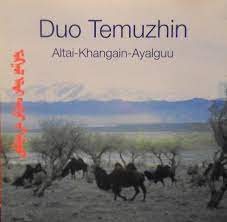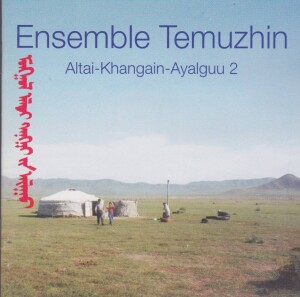 Big Earl Sellar wrote this review.
Big Earl Sellar wrote this review.
This is sort of a full circle review for yours truly. My first review (my “audition,” if you will) for Green Man was Tsagaan Sar’s White Moon, a disc of music from Mongolia. And now I have some more glorious Mongolian discs to share with you, courtesy of the fine folks at Face Music. I recommend you hunt these discs out, even if your listening tastes aren’t especially esoteric, as you will find some of the most incredible music produced on this planet.
Cross together the music of the indigenous people of the Americas with Celtic and Northern Chinese (and roughly in that ratio) and you have Mongolian music. Asian enough to seem “foreign,” yet sounding more than Western enough to not scare the ears off you, it is a profoundly moving music. It is utterly strange at points, and yet so familiar as to make the listener hum along. Obviously coming from the same melodic family as the First Nations, but with a range more common to Scandinavia, Mongolian music is almost the ultimate World Fusion music. Almost, because the inhabitants came up with it themselves over their millennia of occupation on the steppes.
Duo Temuzhin consists of two very traditional artists. Batsaikhan plays the morin khuur, a sort of cello with two strings, yet capable of a broad range of tones. Vavgaan plays the khun tov shuur (rather like a lute), the aman tsuur (a recorder), various Jew’s harps, and sings. But singing in Mongolia is rather different than most other cultures. The range a vocalist is expected to have surpasses what any other culture on earth would dream of. They have to master singing in high, normal and low pitch; in guttural tones; and hoormij, or double octave singing, where a guttural drone and a high pitched melody are song simultaneously. Hoormij (sometimes called throat singing) is a fine art, creating a sound somewhere between the wind and a modern synthesizer. Vavgaan is a master of the technique, and this wonderfully recorded disc shows off his abilities brilliantly.
The traditional showcase song of this technique, also called “Hoomij,” is an otherworldly highlight of this disc: Vavgaan is capable of alternating his range, sometimes adding hints of third overtones (a vocal chord!) to his drone. Batsaikhan is a master of the morin khurr and gets in many great solo tracks as well; his take of “Mandal juujee,” highly ornamented and veering from Oriental to Occidental and back, is simply breathtaking. Join the two together, as “Kholin Gazar,” and the listener is treating to the finest renditions of some of the most beautiful music on this planet. The recording is superb, the liner notes are thorough (if somewhat awkward in their translated form), and the photos are suitable cheesy enough (there is an overtly strong tendency to photograph Mongolian musicians in their most outlandish formal costumes, as opposed to their everyday clothes) to call this a masterpiece of the genre. This is a strongly recommended introductory disc.
 Ensemble Ardin Ayalguuis is fronted by Batsaikhan, this time in a quartet group setting, featuring yoochin (a hammered dulcimer), khuuchir (a higher pitched relative of the morin khuur), and limbe (transverse flute). The music is slightly more Oriental sounding as a result, but still unmistakably Mongolian in its almost indescribable melodic bent. The interplay between the yoochin and the morin khuur is spellbinding: at times complex lines woven at breakneck speeds; at others, simple passages played with great emotion. Singer Enkhjargal presents some slightly more typical hoomij singing, in a higher pitch and not quite as gymnastical as Vavgaan. As an ensemble, the works tend to be cohesive without sounding too similar. The gentle “Sender okhin,” featuring the four-way rhythmic interplay of the instruments, countered by the long/short sustain each brings to the piece, is a particularly wonderful track. Again, extensive (if not smoothly translated) liner notes, pictures of hokey costumes, and superb recording round out this disc.
Ensemble Ardin Ayalguuis is fronted by Batsaikhan, this time in a quartet group setting, featuring yoochin (a hammered dulcimer), khuuchir (a higher pitched relative of the morin khuur), and limbe (transverse flute). The music is slightly more Oriental sounding as a result, but still unmistakably Mongolian in its almost indescribable melodic bent. The interplay between the yoochin and the morin khuur is spellbinding: at times complex lines woven at breakneck speeds; at others, simple passages played with great emotion. Singer Enkhjargal presents some slightly more typical hoomij singing, in a higher pitch and not quite as gymnastical as Vavgaan. As an ensemble, the works tend to be cohesive without sounding too similar. The gentle “Sender okhin,” featuring the four-way rhythmic interplay of the instruments, countered by the long/short sustain each brings to the piece, is a particularly wonderful track. Again, extensive (if not smoothly translated) liner notes, pictures of hokey costumes, and superb recording round out this disc.
 Ensemble Temuzhin features Vavgaan in a trio setting with morin khurr and yoochin. A mellower disc than the Duo, it acts as a showcase for Vavgaan’s multi-instrumental ability and extraordinary voice. On “Khogon-Khan uuliin magtaal,” Vavgaan switches between straight singing and hoomij on each line, creating a cohesive melody that crosses four octaves. Move forward to “Junden Googoo,” and we have a showcase of yoochin by the player Selenge, sounding like a kyoto track crossed with a Blackfoot medicine chant, all on an instrument with a timbre close to the European dulcimer. This disc really illustrates the common ground that much of Mongolian music has with that of other cultures. It is a little slower-paced than the other two discs, but the intensity of the performances makes up for it. The liner notes (which go into a great deal more history of the region) are a little stilted here as well, and the packaging is a little rougher than the other two discs (at least the cover shows people dressed in everyday clothing!), but it’s still a remarkable disc overall.
Ensemble Temuzhin features Vavgaan in a trio setting with morin khurr and yoochin. A mellower disc than the Duo, it acts as a showcase for Vavgaan’s multi-instrumental ability and extraordinary voice. On “Khogon-Khan uuliin magtaal,” Vavgaan switches between straight singing and hoomij on each line, creating a cohesive melody that crosses four octaves. Move forward to “Junden Googoo,” and we have a showcase of yoochin by the player Selenge, sounding like a kyoto track crossed with a Blackfoot medicine chant, all on an instrument with a timbre close to the European dulcimer. This disc really illustrates the common ground that much of Mongolian music has with that of other cultures. It is a little slower-paced than the other two discs, but the intensity of the performances makes up for it. The liner notes (which go into a great deal more history of the region) are a little stilted here as well, and the packaging is a little rougher than the other two discs (at least the cover shows people dressed in everyday clothing!), but it’s still a remarkable disc overall.
I’m very biased toward the music of Mongolia; it is a tradition that has great breadth, rings familiar in a multitude of ways, and yet is obviously original (and anciently so at that). Face Music has done a wonderful job in tracking down and recording these artists: I can only hope that this is a tradition that will not be lost in this ever-shrinking world. Truly stupendous.
Duo Temuzhin’s Altai Khangain Ayalguu (Face Music, 1997)
Ensemble Ardiin Ayalguu’s Solongo (Face Music, 1998)
Ensemble Temuzhin’s Altai Khangain Ayalguu 2 (Face Music, 1998)
